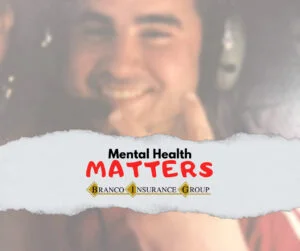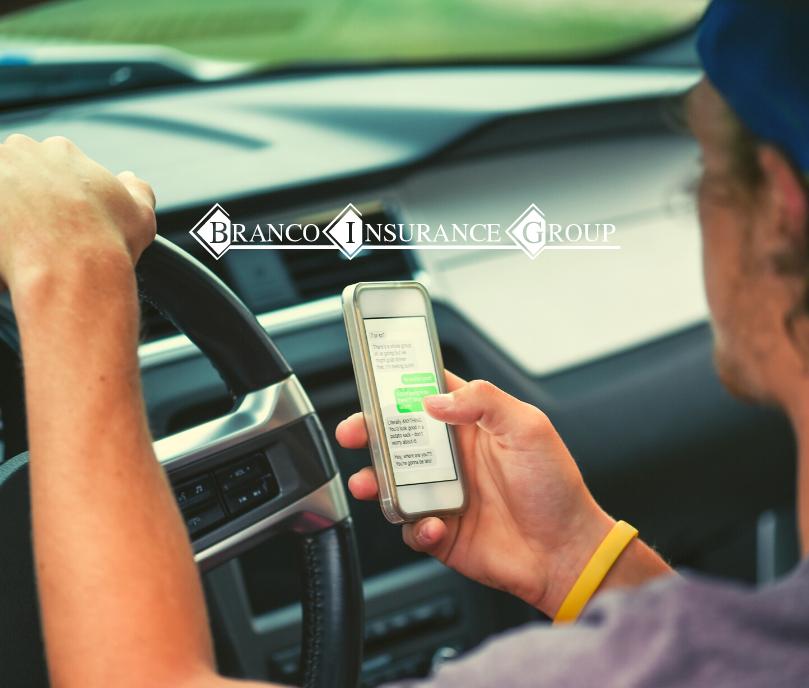
Mental Health Awareness Month: Prioritize the Mind, Support the Heart
May is Mental Health Awareness Month, a time to reflect on the importance of emotional well-being and the invisible battles many face daily. At Branco

Every day, people are injured or killed in car accidents due to distracted driving. In fact, it’s become such a problem that many states have passed laws banning activities like talking on the phone or texting while behind the wheel. Despite these laws, though, distracted driving remains a serious issue. So, what can you do to ensure you’re safe on the road? Let’s take a look at a few tips.
Driving while distracted is a dangerous epidemic on American roads. According to the National Highway Traffic Safety Administration (NHTSA), in 2020 alone, over 3100 people were killed in crashes involving distracted drivers, and an estimated 324,000 were injured. The use of cell phones while driving is the most common form of distracted driving, but it is not the only one. Taking your attention off of driving can be a distraction and increase the likelihood of a car accident.
There are three types of distractions while driving: visual, manual, and cognitive.
• Visual: Taking your eyes off the road
• Manual: Taking your hands off the wheel
• Cognitive: Taking your mind off what you are doing
Any of these distractions can endanger the driver, passengers, and anyone else sharing the road. It is important to be aware of all three types of distractions and how to avoid them.
The best way to avoid being involved in a crash is to eliminate distractions while driving. Here are some tips on how to do just that:
According to the CDC, a distracted driver is reported to be responsible for nine deaths every day in the United States. It is important to be aware of all possible driving distractions and know how to avoid them so we can make our roads safer for everyone involved—drivers, passengers, and pedestrians alike.
Any activity that diverts attention from driving is considered distracted driving, including talking or texting on your phone, eating, drinking, talking to other passengers, fiddling with the radio, entertainment system, or navigation system—anything that takes your attention away from the task of driving safely.
Driving distracted can result in missing an exit, decreased reaction times, swerving out of your lane and into oncoming traffic, or even causing a fatal accident. The number of fatal crashes involving distraction on U.S. streets in 2016 alone was 3,450. That’s nearly 10% of all crash fatalities that year.
You can distract yourself in three different ways: visually (by looking away from the road), manually (by taking your hands off the wheel), and cognitively (by taking your mind off driving). Here are some examples of activities that fall into each category:
Visual distractions include:
Manual distractions include:
Cognitive distractions include:
When you’re driving, you need to pay close attention to the task at hand. It is dangerous to do anything less than this, as it puts yourself and others at risk. Make sure you pull over to a safe location before doing anything that will take your attention away from driving. When a distracted driver is behind the wheel, if you’re a passenger, speak up. Your life may depend on it.
Despite the well-publicized dangers of distracted driving, many people continue to engage in this risky behavior. If you’re one of those people, here are 12 tips to help you stop.
1. Understand the risks. The first step to stopping anything is understanding why it’s harmful. Distracted driving can be classified as one of three types: visual (taking your eyes off the road), manual (taking your hands off the wheel), or cognitive (taking your mind off driving). Any of these can increase your chances of being involved in an accident.
2. Put down your phone. One of the most common distractions is cell phone use. If you can’t resist the urge to check your phone while you’re driving, put it out of reach, so you’re not tempted. Alternatively, consider using a hands-free device for calls and texts so you can keep your hands on the wheel and your eyes on the road.
3. Be a passenger, not a driver. If you’re sitting in the passenger seat, take that opportunity to catch up on work or return some texts or emails. Once you’re back behind the wheel, you can give your full attention to driving.
4. Know when to pull over. If you need to use your phone for directions or have an important call to make, pull over to a safe location before using your device. It’s better to arrive late than not at all.
5. Be aware of other distractions. It’s not just phone use that can be distracting; there are many other potential sources of distraction, including passengers, music, food, and even daydreaming. Be aware of anything that takes your focus off the road, and do what you can to minimize those distractions.
6. Practice mindful driving. The best way to avoid being distracted is by being present while you’re driving and making a conscious effort to focus on the task at hand.
7. Use technology to your advantage. There are many new devices and apps designed specifically to help drivers stay focused on the road.
8. Stay well-rested. Drivers who are drowsy or distracted are equally dangerous.
9. Plan ahead. If you know you’ll be facing a long drive or difficult roads, plan ahead so you can stay focused.
10. Avoid driving if possible. If there are other options available, like taking public transportation or carpooling, take them! Not only will it help reduce traffic, but it can also help you avoid temptation.
11. Take breaks often. If possible, take breaks every couple of hours so you can rest and recharge.
12. Drive with someone else. A Passenger can help with navigation, provide planner support, and be another set of eyes on the road.
Follow these tips and stay safe on the road!
You’re driving down the highway and you see the car in front of you weaving in and out of its lane. As you get closer, you can see the driver looking down at their phone. This is a prime example of distracted driving, and it’s a serious problem on America’s roads.
Before we get into the signs of distracted driving, let’s first define what it is. Distracted driving is any activity that diverts a person’s attention away from the task of driving. This can include anything from talking or texting on the phone to eating, drinking, talking to passengers, adjusting the radio, or even daydreaming.
If you do any of these things, you are more likely to be involved in an accident. However, texting while driving is particularly dangerous because it involves all three types of distractions: visual (taking your eyes off the road), manual (taking your hands off the wheel), and cognitive (taking your mind off the wheel). Six times as many accidents are caused by texting while driving as by drunk driving.
Now that we know what distracted driving is let’s look at some signs that indicate someone may be doing it. If you see someone exhibiting any of these behaviors while behind the wheel, it’s best to give them a wide berth:
The best way to avoid being involved in a distracted driving crash is to simply not do it yourself. Put your phone away before you start driving, and resist the urge to use it even if you’re stopped at a light or in heavy traffic. Pull over to a safe spot if you need to make a call or send a text. And if you’re ever feeling tired or sleepy while behind the wheel, don’t hesitate to pull over for a nap or cup of coffee. Your safety—and the safety of those around you—is always more important than reaching your destination a few minutes earlier.
We’ve all seen it before: the driver who is texting while behind the wheel or the one who is fumbling with their GPS. Distracted driving has become an epidemic on our roads, and it’s time to stop it.
Distracted driving is any activity that diverts attention from priming, driving, and operating a vehicle. This can be anything from using a cellphone to eat something to adjusting the radio. And while you may think that you’re a great multitasker, the truth is that most people are not. In fact, studies have shown that distracted driving can slow your reaction time by as much as 50%.
Visual distractions occur when you take your eyes off the road. This can be anything from looking at a map to rubbernecking at an accident. Even if you only take your eyes off the road for a second, that’s all it takes for an accident to happen. That’s why it’s so important to keep your eyes on the road at all times.
Manual distractions occur when you take your hands off the wheel. This includes activities like fumbling with your phone or adjusting the radio. Even if you’re just holding your phone in your lap while you’re driving, that’s still considered a manual distraction because you’re not in full control of your vehicle.
Cognitive distractions occur when you take your mind off of driving. This can be anything from having an engaging conversation with a passenger to daydreaming about your vacation plans. Even if you’re staring at the road while you’re distracted, cognitive distractions are just as dangerous as manual and visual ones because your mind is not focused on driving.
The best way to prevent distracted driving is to simply pay attention to the task at hand—driving! That means putting away your phone, minimizing conversation with passengers, and not fidgeting with anything in the car beside the steering wheel and pedals. If you need to adjust something in the car, pull over in a safe location first so that you’re not taking any unnecessary risks. Remember, even though driving may seem like a monotonous task, it’s actually very complex and requires your full attention at all times.
The next time you get behind the wheel, make sure that you’re paying attention to the road ahead—not your phone or anything else in the car. Staying focused on driving can help prevent accidents and keep our roads safe for everyone involved.
Texting while driving is one of the most common and dangerous forms of distracted driving. According to the Virginia Tech Transportation Institute (VTTI), texting while driving makes you 23 times more likely to crash. That’s because when you take your eyes off the road to look at your phone, you miss what’s happening around you. In the time it takes to read or send a text, you could travel the length of a football field – blindfolded.
So what can you do to avoid being a distracted driver? The best thing you can do is put your phone away before you get behind the wheel. If you must use it for directions or for making calls, pull over to a safe location first. You should also avoid eating or drinking while driving, as this can take your hands off the wheel and your eyes off the road. And if you have passengers in your car, ask them to help with things like navigation or adjusting the radio so that you can focus on driving.
The next time you find yourself getting frustrated with a driver who seems to be all over the place, remember that they could be distracted. And if you’re ever tempted to check your phone while behind the wheel, think about how much danger you could be putting yourself – and others – in. By being aware of distractions and avoiding them while driving, we can all help make our roads safer for everyone.
Distracted driving isn’t just dangerous—it’s also illegal in many states. So if you’re looking for ways to improve your safety on the road, here are four tips for preventing distracted driving.
1. Put Your Phone Away Before You Start Driving. This may seem like an obvious one, but it’s worth repeating because it’s so important. If you want to avoid being tempted to use your phone while you’re driving, put it away before you start the car—or better yet, give it to a passenger to hold onto until you reach your destination.
If you must make a call or send a text while you’re on the road, pull over to a safe location first. It only takes a few seconds to do so, but it could save your life—or someone else’s.
2. Avoid Multi-Tasking. We live in a culture of multi-tasking, but when it comes to driving, it’s best to focus on one thing and one thing only: the task of driving safely. Even if you feel like you can handle changing the radio station or GPS while behind the wheel, it’s still not worth the risk, and taking your eyes off the road—even for a second—can have disastrous consequences.
3. Know Your Routes and Pay Attention to Signs. If you frequently drive the same routes (to and from work or school, for example), commit them to memory as much as possible so that you don’t have to rely on GPS directions while behind the wheel. That way, even if traffic is heavy and you can’t always see clearly ahead of you, you’ll at least know which exit to take and which lane changes to make.
And be sure to pay attention to all traffic signs and signals; they exist for a reason! Ignoring them is not only dangerous—it’s also illegal.
4. Drive Defensively. Defensive driving means being alert and aware of what other drivers around you are doing at all times. It also means being prepared for anything that might happen on the road—such as sudden stops or lane changes—and being able to respond quickly and safely . . . without veering into another lane or causing an accident yourself.
Following these four tips can help prevent distracted driving and make our roads safer for everyone involved. Remember: even if you think you can multi-task while behind the wheel, it’s still not worth the risk of being involved in an accident.
It’s no secret that distracted driving is a huge problem on our roads today. Despite the fact that it is such a prevalent and deadly problem, many people still don’t realize just how dangerous it can be.
Driving while distracted increases your chances of being involved in a crash. You’re more likely to miss important things if you’re not paying attention to the road, like a stop sign or a child running into the street if you’re not paying attention to the road. And even if you don’t cause an accident, distracted driving can still lead to costly tickets and collisions that could have been avoided if you had been paying attention.
Putting your phone away and focusing on driving is the best way to avoid distracted driving. You should pull over to a safe location before making a call or sending a text. You should always err on the side of caution if you are unsure whether or not you should be driving, and wait until you can concentrate on the task at hand if you have any doubts. And finally, be sure to buckle up every time you get in the car; not only will it help keep you safe in case of an accident, but it’s also the law in many states.
Distracted driving is a serious problem on our roads today, but it’s one that we can all do something about. By making a conscious effort to avoid distractions while behind the wheel, we can help make our roads safer for everyone.
While the statistics are clear that distracted driving is dangerous, many people still don’t realize just how serious the consequences can be. If you’re caught texting while driving, you could face a fine of up to $1000 in some states. But that’s nothing compared to the other potential consequences of this behavior.
Distracted driving can lead to property damage, injuries, and even death. In fact, car accidents are the leading cause of death for teenagers in the United States—and a large percentage of those accidents are caused by distracted driving. If you’ve ever been involved in a car accident, you know how devastating they can be; not only can they cause physical and emotional trauma, but they can also have lasting financial implications. Medical bills and car repairs can quickly add up, and if you’re unable to work because of your injuries, you could find yourself struggling to make ends meet.
The next time you find yourself picking up your phone while behind the wheel, remember the potential consequences of your actions. No text message or social media post is worth putting yourself or others in danger. Drive safe and wait until you reach your destination to check your phone.
Distracted driving is a leading cause of car accidents, injuries, and deaths. Despite the dangers, many people continue to engage in this risky behavior. Whether they’re texting, talking on the phone, eating, or fiddling with the radio, distracted drivers are putting themselves and others in danger.
While it’s important to be aware of the dangers of distracted driving, it’s also crucial to know the warning signs. By understanding the signs of a distracted driver, you can take steps to avoid an accident.
The warning signs of a distracted driver can vary depending on the type of distraction. For example, a driver who is texting may veer off course, tailgate other cars, or make sudden stops. A driver who is talking on the phone may have problems staying in their lane or misses traffic signals. And a driver who is fiddling with the radio may drive erratically or swerve between lanes.
In addition to these behaviors, there are some general warning signs that indicate a driver is distracted. These include:
If you see any of these behaviors in another driver, it’s best to give them plenty of space and avoid passing them if possible. You should also be prepared to take evasive action if necessary.
Distracted driving is a leading cause of accidents for all drivers, regardless of age or experience level. By knowing the warning signs of distracted driving, you can help keep yourself and others safe on the roads. If you see another driver exhibiting any of the behaviors mentioned above, give them space and be prepared to take evasive action if necessary.
Distracted driving has become a huge problem on our roads, and it’s only getting worse. In this blog post, we’ve outlined some of the most common distractions that drivers face every day. We also shared some tips for how to stay safe on the road while avoiding these dangerous distractions. It’s important for all drivers to be aware of these dangers and take steps to avoid them. Distracted driving can lead to serious accidents and even fatalities.
Distracted driving not only puts your life and the lives of those around you at risk, but it also puts your vehicles at risk. If you end up in an accident as a result of distracted driving, your insurance rates will likely go up, and you may even lose your insurance coverage entirely. So, it’s important to take distracted driving seriously and do everything you can to avoid it.
We hope that you take what we wrote here to heart and make an effort to drive distraction-free. If you have questions about how distracted driving might affect your insurance cost or want to know how to get the best value for your auto insurance, our experts at Branco Insurance Group are here to help. Contact us today to learn more, and let us know what you think about distracted driving.
Share your own tips for staying safe in the comments below.

May is Mental Health Awareness Month, a time to reflect on the importance of emotional well-being and the invisible battles many face daily. At Branco

Two of Naugatuck’s long-standing insurance professionals have joined forces. Beginning on April 14th, the Healy-Lynn Insurance Agency has become a division of Branco Insurance Group.
